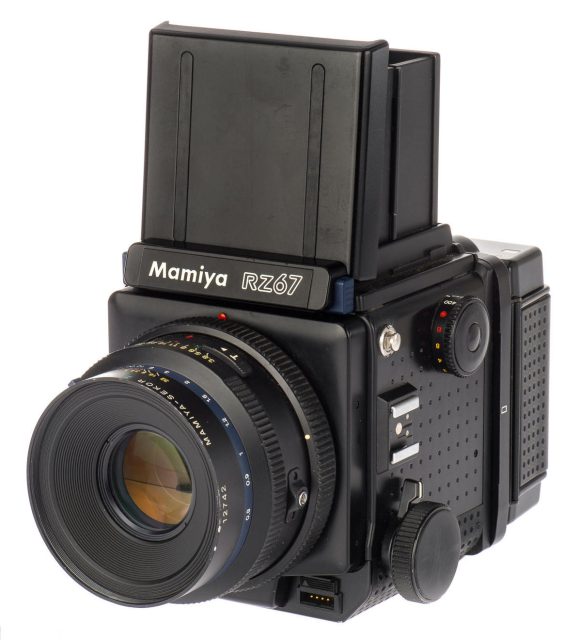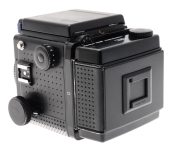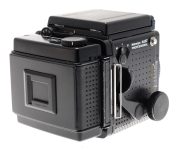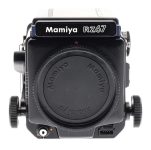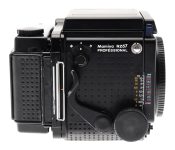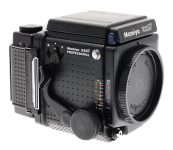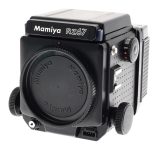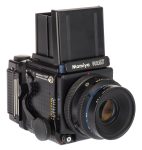Announced
Production status
System
Mamiya RZ67 system cameras
Mamiya RZ67 Professional
Medium format MF film SLR camera • Discontinued
Specification
| Format: | |
| Medium format 6x7 | |
Film type: | 120 roll film |
| 220 roll film | |
| Mamiya RZ67 [104mm] | |
| Shutter: | |
Type: | In-lens leaf shutter |
| Exposure: | |
Exposure metering: | None |
Exposure modes: | Manual |
| Physical characteristics: | |
Weight: | 2400g |
Dimensions: | 133.5x104x211.5mm |
Manufacturer description #1
The World's Most Versatile, Most Responsive Medium-Format Single-Lens Reflex Photographic System - MAMIYA RZ67 Professional
The primary development theme behind the exciting new Mamiya RZ67 Professional was the need for a photographic system capable not merely of handling the many challenges that face today's professional, but handling them with an ease and versatility that would leave the photographer free to concentrate solely on the creation of the image. And this, naturally, required the development of an entirely new series of lenses, which Mamiya also created, that surpass in quality even the famed RB Series lenses. These new RZ Series optics have been designed and produced to offer absolute accuracy to the photographer, sharp, clear images of outstanding color rendition and contrast. The combination of RZ67 and RZ Series lenses creates a photographic tool that meets fully and completely all the severe challenges and demands of modern professional photography to allow total dedication of the photographer's attention to the important task of creation. Every function and operation, every control and feature, every component and accessory has been designed and developed to require absolutely minimal distraction from the photographer's primary need-achievement of the desired image. From the basic, physical, act of holding and operating the camera to the electronic and optical parameters of performance, the RZ67 Professional has been designed to make minimal demands on the photographer-excepting the photographer's imagination and creativity, which the design both challenges and enhances.
The photographer enjoys the capability to do more with the RZ67, because the camera requires so much less. Fundamentally, the new RZ67 Professional follows the basic design of the internationally acclaimed Mamiya RB67 system: a single-lens reflex design in the proportionally ideal 6 x 7cm medium format, with interchangeable lens shutter optics, interchangeable/revolving film backs and integral rack-and-pinion bellows focusing system.
But the RZ67 Professional incorporates major advances in lens performance, handling ease, electronic operation and control functions, along with new system accessories, to give the photographer more and simpler creative potential than ever before available. And all this while retaining maximum compatibility with the lenses and system accessories of the RB67 system.
Simplified Handling & Operation Provide Greater Response, Less Distraction
Some of the most important advances of the new Mamiya RZ67 Professional are in the area of handling and operating the camera body. One significant contribution to more responsive and easier handling has been the integration of the shutter cocking and film advance systems, so that both actions are accomplished by means of a single lever.
This improved mechanism works in both horizontal and vertical formats, and requires far less pressure on the side charging lever, which is set at an angle to fit hand position perfectly when the camera is held in a natural grip.
The basic waist-level finder opens and closes smoothly, with a single touch, as does the built-in focusing aid magnifier, which accepts the same diopter correction lenses available for the RB67 camera.
A second distinct advantage of the new RZ67 is its automatic masking feature. With this camera body, moving frame masks are coupled directly to the revolving mechanism of the film back, so that the finder is correctly masked for either vertical or horizontal format. As the film back is revolved, the mask appears in place in the viewfinder automatically. Thus the photographer is always aware of the proper format while looking through the viewfinder, without any need to check the position of the film back. This is a considerable advance in the elimination of distractions during professional work.
Automatic masking operates under all circumstances, no matter which RZ system film back is employed, or which finder is in place.
Since the revolving mechanism for film backs is now built into the camera body itself, film flatness is improved for sharper images, and the reliability of the mechanical system is considerably enhanced. A special feature of the RZ67 body is a three-position switch incorporating the lock release for revolving film backs (R) and the multiple exposure function (M). This switch returns automatically from (R) to the neutral position when either the charging lever is slightly advanced, or the shutter release given slight pressure.
When the multiple exposure (M) setting is activated, the charging lever will recock the shutter without advancing film, so that a second exposure can be made on the same frame.
Finally, the RZ67 Professional now accepts its very own motor winder, allowing sequential photography, faster reaction to movement and remote control photography - all vitally important considerations to the working professional.
Sophisticated Electronic Advances For Professional Applications
The past decade has seen considerable progress made in the application of advanced electronics to photography. Now, the Mamiya RZ67 Professional incorporates a host of new electronic features designed to make the professional's job faster, simpler and easier than ever before.
Everyone of the electronic circuits built into the RZ67 body is present for the specific task of providing greater shooting advantages to the professional. At the same time, the use of sophisticated electronics allows not only greater precision in the process of exposing the film, but also provides a higher degree of performance reliability and camera durability, two of the factors most important in the selection of professional photo equipment.
Among the electronic advances incorporated into the RZ67 body are an entirely new electromagnetic shutter release system (which provides the basis for remote control accessory use). A system of monitor lamps clearly visible in the viewfinder, dark slide interlock and a special audible warning that precedes automatic power cut in the Bulb shutter speed or Mirror-Up modes. The electronic circuitry also provides the required linkages for such advanced electronic accessories as the PD Prism Finder, Winder RZ and MZ Flash units.
The new electromagnetic shutter release of the RZ67 Professional increases timing precision in the actual taking of the photograph, and also affords improved durability and reliability. Also, since the RZ67 accepts both electronic RZ system and mechanical RB system lenses, the shutter release incorporates a three-position ring with setting for Lock, Electromagnetic (RZ/RB lenses) and Mechanical (RZ at 1/400 sec., RB at all speeds) release modes.
An electronic innovation of the RZ67 Professional is the incorporation of a shutter speed dial on the camera body, rather than the usual lens shutter system of speed selection rings on each individual Iens. This dial incorporates settings for speeds from 8 to 1/400 sec., and Bulb (B). The proper speed is relayed from body to lens via a series of special contact points on the lens and body mounts. Since power is consumed by an open electronic shutter, the RZ67 sounds a warning buzzer when 50 seconds have elapsed on a B shutter speed. This warning continues for 10 seconds, after which power is cut off automatically to prevent over-drainage of the battery. For longer exposures, the T setting (mechanical) is recommended.
Three monitor lamps are now provided in the viewfinder to allow the photographer to check the operating condition of the camera while continuting to observe the subject. The red LED lights to indicate that the dark slide has not been properly removed from the film back (and also flickers to indicate battery power loss). If the charging lever has not been fully extended, and either shutter recocking or film advance are incomplete, an orange LED will light. Finally, a special green LED lights up to indicate completed recycling of the MZ Series flash units when attached to the RZ67 body. (NOTE: Monitor Lamps do not function in Mechanical Release mode.)
A convenient operating mode of the RZ67 Professional is Mirror-Up photography. A double cable release is used, linked to the mechanical cable release socket on each RZ Series lens, and the shutter release button. Slight pressure on the cable release then puts the body into mirror-up condition, after which full pressure releases the shutter. This is especially convenient in close-up and macro photography, to completely eliminate vibration. (NOTE: The auto warning and power cut-off feature functions in this mode if mirror-up condition is maintained for 50 seconds, in order to prevent power drainage.)
Large Controls & Special Finish Guarantee Secure Holding & Positiye Control Of All Functions
The complete restructuring of the RZ67 Professional camera body has led to a slightly more compact design than the RB67 model, despite the many new features incorporated within that body.
And the body itself has been designed and finished to allow photographic professionals both the positive control and the secure grip necessary to handling ease.
Designel's working on the camera body decided to employ a rubberized finish on all areas of the camera that come in contact with the photographer's hands. These include the side and underside panels, film back grips and lens mount ring. This special finish provides an exceptionally secure grip, with no fear of slipping, that is in large part responsible for the unique 'feel' of the body and contributes greatly to improved handling ease.
There are, at the same time, no design frills on the body, no unnecessary decorative effects. The RZ67 is a completely functional camera; its controls fall naturally into place, just where they belong. And each control on the body surface is large enough to provide sure operation, and positioned for rapid, positive response to the photographer's needs.
In addition to all these vital design elements adding to ease of operation, the RZ67 also offers a particularly 'clean' finish , with protrusions eliminated to the maximum extent. A good example of this is the folding handle of the dark slide, which keeps the side of the camera body smooth. This type of detail may appear quite minor, but professionals know that just such minor details can make the difference between a camera body that 'looks good' and one that 'performs' to the maximum.
Dimpled surface finishing of both camera body and film backs, combined with the sure-grip rubberized finish used at hand-contact points, means a control 'feel' that particularly suits the hard- working professional. After just a few minutes of familiarization, any pro will be able to handle the RZ67, even in pitch darkness, with certainty that every function is operating just as desired, every control in proper position.
A good example of the attention to detail provided by the RZ67 Professional is the charge lever. A lot of thought went into the design of this vital control, particularly into the contour of the thumbpad. The charge lever can be operated positively and rapidly even while the photographer keeps eye to the view- finder for the next shot.
Focusing is, of course, one of the most vital factors in the production of a genuinely professional quality photograph. So that focusing with the RZ67 Professional will be positive, sure and precise, the large twin knobs of the camera's rack-and-pinion bellows focusing system are given the same sure-grip rubberized finish as other contact points. And this finish is also used on the vital lens mount ring, so that the photographer always has positive control feel under any circumstances.
5mall-but-vital features are the strongest point of the RZ67. Although the basic camera system is completely finished in black, two vital controls are accented in blue. This provides not only a hint of color, but more importantlv an indication of use and operation, as well. The release buttons of the camera finder is one of these areas; the special depth-of-field ring on each RZ system lens is the other. While the aperture ring and lens mount ring are both finished in black, this depth-of-field indication ring is given a smooth, blue finish to distinguish it and to allow quicker identification during operation of the camera.
Manufacturer description #2
Building upon its long experience since the introduction in 1970 of the revolutionary RB67 SLR with revolving back and the later refinements incorporated into the RB67 Pro-S, Mamiya Camera Company has utilized the latest electronic technology in order to fulfill its commitment to advanced amateurs and professional photographers by producing the ultimate 6 x 7cm camera, the Mamiya RZ67.
The result is a camera with incredible versatility and handling ease. ideally suited for commercial, industrial, scientific, news, portrait, scenic, and fashion photography. In fact, the Mamiya RZ67 knows no bounds in photographic application.
The following exemplify how the outstanding features of the RB67 have been further refined in the Mamiya RZ67, resulting in unprecedented quality and performance.
1. Ultra Performance Lenses
Without changing the outer diameter of the lens mount on the camera body, the inner diameter of the mount on the RZ67 has been increased by 7mm (from 54mm on the RB to 61mm on the RZ). Furthermore, the flange back (distance of the lens mount to film plane) has been reduced by the same amount (from 111 mm on the RB to 104mm on the RZ).
The increase in size of the diameter of the mount and decrease in the distance of the flange back have made it possible to design a new series of ultra performance lenses designed exclusively for the Mamiya RZ67, offering performance previously believed unattainable. It is now also possible to design new, specialized optics, such as shift or high speed lenses.
Moreover, any RB lenses already in the possession of the photographer can be used on the RZ67 without an adapter or loss in performance.
2. Improved Handling
It is now possible to advance the film and Exposure Counter, set the mirror and Light Baffle, and cock the lens with a single stroke of the Cocking Lever.
With Winder RZ attached to the camera body, a gentle touch of the electromagnetic release makes it possible to effortlessly take consecutive photographs.
As the revolving back is rotated to change from horizontal to vertical format, or vice versa, the viewfinder masks also simultaneously change automatically, preventing the photographer from seeing anything other than the area actually being photographed.
While retaining the “T” (time) setting on the lens, a “B” (bulb) setting has been incorporated into the Shutter Speed Dial of the camera body for added versatility.
The mirror-up mechanism is now automatically engaged as soon as a cable release is attached to the Mirror-up Socket.
3. Improved Performance
Shutter speed accuracy and durability have been significantly enhanced by utilizing an electromagnetic release and Mamiya’s own Moving Coil system in conjunction with the Seiko #1 electronic shutter. Additionally, the longest fixed shutter speed has been increased to 8 seconds, making the camera more flexible than ever.
When the camera is not prepared for use, the shutter release automatically locks and awaming lamp illuminates in the viewfinder, informing the photographer precisely what needs to be done, a red lamp indicating that the Dark Slide must be removed from the Film Holder, and an orange lamp reminding the photographer to advance the Cocking Lever.
When using a Mamiyalite electronic flash, a green LED illuminates in the viewfinder when the unit is fully charged and ready to fire.
For viewfinders with built-in exposure meters, the film speed, shutter speed, and aperture information is electronically transmitted to the exposure meter.
With a Mamiyalite MZ36R or MZ18R attached to the RZ67, aperture and film speed information is automatically and electronically relayed to the flash unit, controlling its light output.
By attaching Winder RZ and Receiver MZ to the RZ67, remote control of the camera is possible with Transmitter MZ, thereby immensely increasing the applications of the camera.
***
CAMERA TYPE: 6 x 7cm roll film SLR with lens shutter.
FILM TYPE: Uses 120 (10 exposure) or 220 (20 exposure) roll film. Actual negative size of 56 x 69.5mm.
LENS MOUNT: Large diameter (61 mm) bayonet (breech lock) mount with built-in safety lock and 12 electrical contacts. Accepts RB lenses without an adapter.
SHUTTER: Seiko #1 electronic shutter; B, T, 8-1/400 sec.; mechanical shutter speed of 1/400 sec. usable without a battery; built-in Shutter Release Button safety lock and manual lock provided.
FOCUSING HOOD: Opens and closes with a single touch: equipped with 3.2 x Magnifier (interchangeable with 5 other diopter lenses): 95% of the field of view visible; several interchangeable viewfinders available.
FOCUSING SCREEN: All matte with Fresnel lens and instantly interchangeable.
VIEWFINDER INFORMATION: Orange warning lamp illuminates when Cocking Lever has not been set or properly advanced. Red lamp illuminates when Dark Slide has not been withdrawn; also doubles as battery check lamp. Green lamp illuminates when Mamiyalite electronic flash unit is fully charged.
REVOLVING BACK: Back revolves 90 deg. to change from horizontal to vertical format, or vice versa. Viewfinder format automatically changes as back revolves.
FOCUSING METHOD: Rack and pinion focusing extends built-in bellows up to a maximum of 46mm. Focusing Knob provided with Lock Lever.
FILM TRANSPORT: A single 114 deg. stroke of the Cocking Lever advances the film and Exposure Counter, sets the mirror and Light Baffle, and cocks the shutter.
FILM HOLDER: Interchangeable holders are available for various film types.
MULTIPLE EXPOSURE: The built-in automatic double exposure prevention mechanism can be overridden with a single touch of a lever, providing multiple exposure provision.
BATTERY TYPE: One 6V silver-oxide battery (4SR44) or 6V alkaline battery (4LR44).
ADDITIONAL: Camera has remote control capability and mirror-up capability (for vibrationless photography).
From the editor
The weight and dimensions are indicated for the camera body with the Mamiya-Sekor Z 110mm F/2.8 lens mounted.
